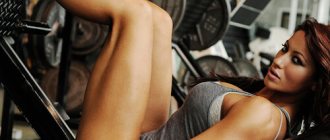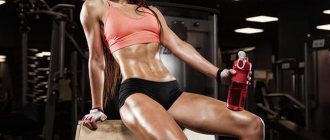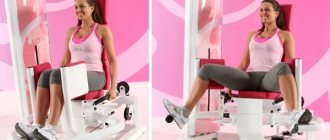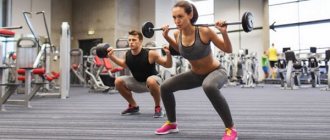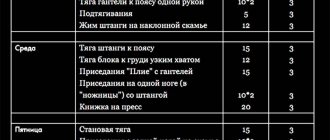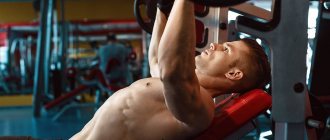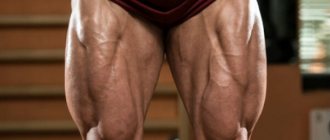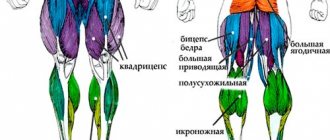28 June 2021 Admin Home page » Tips and tricks
Find out how to build broad shoulders as quickly as possible, with minimal risk of injury. Only proven advice from professionals!
Many gym goers use the rule, lift more and you will get bigger, these words have some truth, but they need to be used wisely. Dumb lifting of weights will give initial results, but then you will not get the long-awaited effect and your results will stall, plus you will get injured.
To do this, you need to connect your brains, use different training schemes, apply different degrees of load, and so on. We present to your attention 16 main rules for the correct development of shoulders, with minimal possibility of injury, remember them so that training your shoulders for weight will be successful.
It starts with the overhead press
Start working on your deltoids with a seated press while you are full of strength and energy; you can do it with both a barbell and dumbbells; it is better to alternate them, rather than focus on one of them. This basic exercise perfectly works all 3 areas of the deltoids, triceps and other supporting muscles; it is very important to work in the range of 6-12 repetitions, this is where muscle hypertrophy comes into play.
Do not try to do this exercise at the end of a workout, when the muscle fibers are working with the rest of their strength, you lift a small working weight, and you will not work the muscles well.
Do seated and standing presses
There is no fundamental difference between these 2 exercise options, but there is one significant difference.
When performed in a seated position, you work the shoulders more specifically, which is better for more targeted delt pumping, but it doesn't allow for the use of lower body strength. Therefore, you can handle the weight, much less, and reduce the number of repetitions.
If you use the standing option, this is called a military press, here you can work with heavier weights and increase the number of repetitions, due to the fact that the initial impulse of the movement comes from the lower part of the body, including the legs, abs, and lower back in the work. It is recommended to use an athletic belt in heavy approaches so as not to damage the lower back. Precisely because more weight is taken, more muscles are involved in the work and the mass of not only the shoulders, but also the whole body increases.
Alternate these exercises, this will give impetus to the development of large deltoids.
Why don't my deltoid muscles grow? (How to fix it?)
Are you often looking for ways to pump up your shoulders, but there are no results yet? I can congratulate you, you have come across the right article and will be able to solve this issue. Here I will clearly demonstrate how to properly pump and quickly build up the deltoid muscles in order to ultimately get bigger and stronger shoulders.
For many, the deltoids are an extremely difficult muscle group to train. It is worth noting that for most athletes it is not difficult to work the front delts, but when it comes to the lateral delts, this is where the difficulties begin. The lateral delts are precisely the muscles that demonstrate our texture and determine the width of the shoulders, which many strive to increase in volume.
But in practice, working out the side delts is not so difficult. Dumbbell lateral raises are generally the most effective way to achieve great results. And in fact, perhaps many of you who are reading this article perform similar exercises in everyday life, often without noticing it.
But then why don’t you see muscle growth in your shoulders? And you constantly wonder: how to pump up deltoids? So, in fact, it all depends on how correctly you perform the exercises, which at first glance are very simple.
Incorrect technique for performing dumbbell flyes
It's actually very rare to see gym goers actually perform this exercise properly. Instead of pumping specifically the lateral delts, they actually and unconsciously train other muscle groups. This occurs because athletes put unnecessary tension into their movements, swaying from side to side, back and forth while performing the required movements.
The upper trapezius muscles take on some of the work and relieve the load on the deltoids
In addition to this, one of the lesser known causes that we are not even aware of is the upper trapezius muscles. There are many reasons why they take most of the load from the deltoid muscles during exercise. Here are the most important reasons:
- Anatomical features of the upper trapezius muscle.
- A hyperactive state of this muscle group, due to a person being in a hunched position for a long time during the day.
For clarity, you can look at the photo below. This shows how the upper trapezius muscles work, and they are the ones that lift the shoulder. At that time, it can be seen that the deltoids are designed to raise the arms to the sides.
So, many of us who will perform raises with dumbbells will also involve our shoulders in the work, so that it is simply easier. This usually happens at the very beginning and at the end of performing a certain number of repetitions of a given exercise.
When you move dumbbells from point A to point B, the side delts lose their engagement at the end of the set. The amplitude is reduced and the movements become incorrect.
How to Minimize Upper Trapezius Muscle Involvement
The problem is also that many people make this mistake on a subconscious level. In practice, it turns out that over time, a familiar mechanism of action is developed and, when we spread our arms to the side, it is the upper trapezius muscles that are activated, not the deltoids.
Of course the trapezius muscles will always be involved to some extent, but they should not be the main ones. And since our main goal is precisely pumping up the deltoid muscles, creating strong and large shoulders, it is necessary to minimize the involvement of the upper trapezius muscles in the training process.
So, how to train correctly.
Make sure your shoulders develop evenly
Uneven development of the shoulders is not only noticeable and unsightly, but can also be the cause of a rotator cuff injury.
Guys who often train their chest and do other exercises to develop it have larger front deltoids than their side ones. At the same time, they do not pay special attention to the sitting press, because the main thing is to have a beautiful, powerful chest.
Because of this, the shoulders look underdeveloped in appearance, the chest is large, and the shoulders are not wide enough. Not liking traction exercises for the back leaves the rear part of the deltas out of work.
All this leads to weakness of the shoulder joints, which may not withstand the load of strength exercises, as other muscles grow and require more and more load.
The first exercise for the deltas is the bench press, and the second should go to the lagging part of the shoulder, and then to the more developed area.
How often to exercise
If you have just started training and have been training for several months, then there is an optimal scheme for you. You need to pump all muscle groups in one workout three times a week.
To do this you need to use basic exercises. They help grow overall muscle mass.
We recommend reading: How to increase weight in the classic deadlift
After training for several months, you can switch to split and separate training.
You need to divide the whole body into two parts, and train according to the 2+1 scheme, two days of training, then a day of rest. Or 2+1, 2+2.
Let's give an example of how many times a week you need to pump certain muscles:
Monday: you can pump up your chest, triceps, deltoids
Tuesday: trains back, biceps, legs
Thursday: you can pump up the chest, triceps, deltoids
Friday: back, biceps, legs trained
Thus, each muscle group is trained twice a week. During this period, the loads are not yet large enough, so the muscles need several days to recover.
Further, at a more advanced level, after about six months of strength training, an even larger split is drawn up, in which only two muscle groups are pumped in one workout.
We recommend reading: Dietary kebab on the grill: what kind you can eat on a diet, recipes for meat and fish with proper nutrition
Since the muscles will receive increasing stress, they will need more time to recover and continue to grow. Here you need to start adhering to this principle: large muscle groups need to be trained no more than once a week. Small muscle groups require less recovery time, so with a weekly split there are two options for training them, once or twice a week.
What muscles should you exercise how many times a week?
For example, when large and small muscle groups are pumped once a week:
Monday: you need to pump up your chest, triceps
Wednesday: back, biceps training
Friday: deltoids and legs swing
And with this split, large muscle groups are trained once a week, and small muscle groups are trained twice a week. One day, small muscle groups work while pumping up large ones, and the second time, targeted training of these small groups takes place.
Monday: chest, biceps pump (triceps and front delts work during presses)
Calculate your ideal sports weight!
Wednesday: trains back, triceps (biceps and rear deltoids work during back training)
Friday: shoulders and legs swing
Another option is a split, when your arms are trained on one day:
Monday: you need to pump up your chest, deltoids
Wednesday: back, legs trained
Friday: you can pump your arms
Saturday and Sunday: rest
With this split, large muscle groups are pumped once a week, small muscle groups - twice a week.
These are just the simplest examples of strength training, there are many options. When answering the question: how many times a week should you train different muscle groups, you must not forget about the recovery factor. The time that muscles need to recover is determined only empirically, since it is individual for each bodybuilder and depends on various parameters.
How often can you train one muscle group?
For example, if you pumped your triceps in the last strength training, and it didn’t have time to recover, and in the next workout you started pumping your chest, then your results in the bench press will noticeably decrease. Therefore, you need to select a strength training regimen experimentally.
If you are an ectomorph, a split is perfect for you, in which only one muscle group is pumped in one strength training session. Ectomorphs require much more recovery time than athletes with other body types, so one muscle group should be trained no more than once a week.
With age, recovery time increases, so middle-aged athletes should train each muscle group no more than once a week.
Most novice bodybuilders are interested in the question of how many times a week they need to pump one muscle group. In response to this question, bodybuilding experts have the opinion that it is not advisable for beginners to train isolated muscle groups, since in novice athletes the most intense increase in muscle mass is observed when performing basic exercises.
In addition, you need to take into account that beginners in the gym do not want long duration of strength training. An hour or an hour and a half is enough. But girls can pump up their buttocks every day. We talked about this in detail here.
How many times a week should you train muscles to lose weight?
How many times a week should a girl or man exercise to lose weight? To quickly lose excess body weight, you can exercise daily. The minimum amount of strength training for weight loss is three times a week.
For those people who come to the gym just to pump up the muscles of their legs, arms, abs, back, buttocks, strength training should be less intense. A regime of 3 workouts per week is suitable for them. The strength load will depend on how many times a week and what muscles need to be pumped.
How many times a week should girls train to lose weight?
Speaking about training for weight loss, you need to remember about aerobic training for girls. Daily aerobic training while reducing calorie intake can have the opposite effect than desired. Instead of speeding up your metabolism and losing weight, your body may increase the amount of fat it produces instead of burning it.
Losing weight should always start with proper nutrition. Exclusions of fast carbohydrates and excessively high-calorie foods. Physical training for fat burning will only be a way to normalize metabolism and equalize blood sugar levels, and not at all a mechanism for getting rid of excess calories and “burning” fat.
How many times a week to pump your legs
The leg muscles are one of the largest muscle groups in the human body. Therefore, it is advisable to train the leg muscles no more often than once every 72 hours. In other words, if you did heavy barbell squats on Monday, your next leg workout would be Thursday or Friday. However, if you only trained your calves or inner thighs, the time will be reduced.
At the same time, the final number of days required to restore the leg muscles also depends on the person’s body type. Athletic mesomorphs can train more often. They usually build muscle quickly. Whereas the body of thin ectomorphs or overweight endomorphs requires an increased amount of time to replenish energy reserves.
How many times a week should you pump your abs?
Beginning athletes can pump up their abs 5 times a week in the first months of strength training. The presence of “delayed” pain will help you literally feel your abdominal muscles. This will dramatically increase the effectiveness of your abdominal workout. However, we are talking about performing single exercises without additional loads or simple training at home.
Complete sets of exercises for developing abdominal muscles will require about 48-60 hours for recovery. Separately, we note that more frequent training of the abdominal muscles is completely incapable of removing fat from the abdomen. This requires exceptionally proper and balanced nutrition.
The optimal workout plan for pumping muscles throughout the body
One day the legs and buttocks sway; back and arms. The second day you can pump your legs and buttocks; press. On the third day, you can pump your legs and buttocks again; back and arms.
This is done because the leg muscles recover faster and require more time to train them. Abdominal muscles usually take a very long time to recover. Therefore, you can pump your abs once a week. It is better to train the arm and back muscles no more than 2 times a week.
It is best to train in the gym of a fitness center or health center with a personal trainer. He will help you create a training plan. He will tell you which muscles to train how many times a week and will monitor the execution of the exercises. You can learn about this in our publication “What is personal training in sports.”
You can find out how to exercise at home in quarantine during self-isolation “here”.
Take care of your rotator cuff
It is responsible for the circular movements of the arms in the shoulders, so neglecting it can lead to negative consequences. Few train it, it doesn’t matter how much you pump it, it’s not visible, but its main task is not to show off externally, but to balance the shoulder joint.
Rotator cuff - consists of 4 muscles, always before training your shoulders, take small dumbbells in your hands and perform circular movements with your arms, slightly bending your elbows. Perform 10-15 rotations forward and then backward, repeat this for 2-3 approaches.
Gym training program for shoulders
We offer a slightly non-standard training plan. To pump up deltas we will use the superset technique.
- Warm up the shoulder, elbow, and wrist joints.
- Superset: overhead press (4/8-12) + back press in the machine (4/12-15).
- Superset: Arnold press (4/8-12) + dumbbell lateral swings (4/12-15).
- Superset: barbell row to the chin (4/8-12) + Lee Haney row (4/12-15).
This program can be used as an independent training, or included in classes for the legs or back.
React instantly to pain
Sharp pain during exercise is bad pain and is nothing like muscle pain after exercise. If it occurs, immediately finish the exercise and move on to another, similar one.
For example, replacing a barbell bench press with a dumbbell press puts your shoulders in a more natural position, does not break them out as much and is less traumatic, although it does not allow you to take on such a large working weight.
At the first manifestation of pain, do not kill the muscles by clenching your teeth, immediately apply measures - massage, ointments, ice application, otherwise you will be treated by doctors and severe inflammation of the shoulder cuff will leave you behind training for a long time.
Train your shoulders in a variety of ways
Shoulder mass training requires variety; don’t get stuck on the same exercises and don’t perform exercises with the same weight. As muscles adapt to the load, they respond less over time and muscle growth slows down.
Therefore, do different exercises, alternate load phases from heavy for 6 repetitions, to medium for 8-10 repetitions and light for 12-14 repetitions. Change the angles of inclination, body positions, use dumbbells, barbells, exercise machines and crossovers, you can see the full list of exercises here.
The best shoulder exercises for mass
Below are the best shoulder exercises that develop muscle mass strictly with the correct technique and the required number of repetitions. It is important to perform both basic exercises in the gym and isolation exercises.
Anterior delta
In order for the front deltas to be trained in the weight gain mode in the shoulder program, it is necessary to perform exercises in which the front deltoids perform their main function, namely frontal lifts, swings, and presses.
Smith Barbell Front Press
The exercise primarily works the anterior delta bundle. Performed with a wide grip in the simulator:
- Set a vertical bench at an angle of 75 degrees under the barbell, having previously selected the load, sit on the bench so that the bar begins to move from the chest;
- Grasp the barbell with a wide grip, elbows pointing down;
- Remove the barbell from the racks, starting from your collarbones;
- Exhale: lift the barbell as high as possible;
- As you inhale, slowly lower the bar to the starting position without throwing.
Army press
One of the best exercises for increasing shoulder volume.
- Grasp the barbell with a shoulder-width grip;
- Raise the barbell to the top of your chest, elbows down. Do not bend your hands; they should be in line with the forearm;
- Exhale – press the barbell up. Do not spread your elbows, lead in a straight line;
- As you inhale, slowly lower the bar to the top of your chest without touching.
Front beam in Crossover
Exercise to work the anterior deltoid muscle. Performed with a straight handle with your back to the machine.
- Grasp the handle of the lower block on the sides. Turn your back to the machine so that the cable is between your legs;
- With straight arms, hold the handle on your hips;
- Exhale: Raise your arms in front of you to shoulder level. Don't rock your body. Hold for a second;
- Inhale: lower your arms down.
Swing dumbbells in front of you
Frontal lifting of dumbbells in isolation trains the front bundle of deltoid muscles; you can lift dumbbells with both hands at the same time, or alternately.
- Stand with your knees bent;
- Palms with dumbbells on hips. Elbows slightly bent;
- Exhale and perform a frontal swing of your arms to eye level without straightening your arms. Do not help by rocking your body;
- Slowly lower the dumbbells as you inhale towards your thighs. If you alternate, perform exactly the same number of repetitions on each arm.
Middle delta
The following exercises work the middle deltoids.
Seated dumbbell press
When training for mass, this exercise will be indispensable for shoulder growth.
- Rest on the back of the bench at 90 degrees, hold dumbbells above your shoulder joints with your elbows on the floor, all joints should be in the same plane;
- As you exhale, perform a dumbbell press, straightening your arms parallel to each other;
- As you inhale, lower the dumbbells without touching your shoulders.
Barbell row to the chin
This exercise can pump up your shoulders with an emphasis on the middle delta. There is also the option of pulling the barbell to the chin with a wide grip. Let's look at the technique:
- Feet shoulder width apart, knees slightly bent;
- Take the barbell with a wide grip under the shoulder joints;
- Exhale: stretch along the body under the chin, do not bring the bar too high with your hands, just raise it to the collarbones;
- Inhale: lower your arms down, do not move the bar too far from your body.
Smith overhead press
The exercise must be performed on a vertical bench.
- Place a bench under the barbell;
- Sit down and grip the bar wide so that when lowering the barbell behind your head, your neck does not lean too far forward. Avoid additional bending;
- Remove the exercise bar from the clamps, holding it at the top with straight arms;
- As you inhale, smoothly lower the bar to the level of the back of your head, no lower, with your elbows clearly going down along your body;
- Exhale and press the barbell overhead, keeping your elbows slightly bent. Do not lift your back from the bench, do not help with your body.
Dumbbell swings from side to side
Another good exercise for working the middle deltoid. It can also be performed while sitting.
- Hold the dumbbells in front of you at the lowest point;
- As you exhale, swing to the sides to shoulder level, slightly turning your hands with your little finger toward the ceiling. Hold for a second at the top;
- Inhale: lower the dumbbells down.
Rear delta
Below are the best delt exercises that increase muscle mass. These options most affect the posterior deltoids.
Bent over dumbbell swings
You can perform dumbbell swings either standing or sitting.
- Perform a horizontal bend with a straight back.
- The arms hang down, the elbows are slightly bent;
- As you exhale, swing up using your rear deltoids. The elbows are constantly turned towards the ceiling at the top point;
- As you inhale, lower the dumbbells.
Bent-over dumbbell row
Bent-over barbell rows, which can replace dumbbell rows, will also help gain mass in the rear deltoid. The exercise can be performed standing or while resting on a bench at an angle of 45 degrees.
- Take dumbbells in your hands with your feet shoulder-width apart and your knees slightly bent;
- Bend straight back forward, maintaining the position, do not sway;
- As you exhale, perform dumbbell rows from the sides, bending your elbows 90 degrees, bringing them just above your shoulder joints, with your forearms perpendicular to the floor;
- As you inhale, lower your arms freely downwards.
Reverse flyes in the pectoral muscle machine
In an arm abduction machine called Butterfly or Butterfly, perform the exercise facing the machine while abducting your arms using your rear deltoid.
- Sitting facing the machine, place the handles together in front of you, clasping them with your hands in a horizontal position, slightly bending your elbows;
- As you exhale, move your arms with the force of the rear deltas to the sides of the shoulder joints, without lowering your elbows to the floor. At the end of the movement, the arms remain in the same plane with the body;
- As you inhale, slowly return your hands in front of you.
Traction in a Crossover with a rope to the rear beam
Massive shoulder exercises can also be performed in Crossover. This posterior bun exercise is performed from the top block of the machine.
- Grasp the edges of the ropes from the top block with both hands. Step back a little, pulling the cable with your arms straight;
- Lean your body back slightly so that the movement goes in a straight line, and your elbows move as if parallel to the floor;
- With an exhalation, perform a rope row, bending your elbows at right angles, bringing them to shoulder level, after a short pause;
- As you inhale, gradually release the tension by straightening your arms in front of you.

